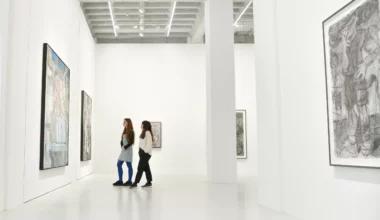If you’re starting an art collection, art galleries are a great place to begin. However, it’s crucial to understand your budget and the art-buying process.
Certificates of Authenticity (CoAs)
CoAs are vital documents that provide key information about an artwork, such as the artist’s name, the medium used, and the creation date. They ensure the authenticity of your purchase and can be an important aspect of your collection.
The Process Doesn’t Have to Be Complicated
Art galleries can feel intimidating for new collectors, with their pristine white walls, discreet staff, and often unclear pricing. But you don’t need formal art education to appreciate what’s on display and to discover your personal taste in art.
Spend time exploring the pieces that attract you, focusing on their aesthetic qualities rather than searching randomly. This approach will help you narrow your choices and avoid regretting impulsive purchases. Creating a Pinterest board or mood board of artworks you like can streamline the process.
Once you’ve identified some favorites, ask the gallery staff for more details about the artist and their work. This information can help you determine whether the piece aligns with your tastes or fits into your collection—learning about the artist’s inspiration or the message behind the work can be particularly enlightening.
Gallery staff can also provide care instructions, which is especially important for sculptures or mixed media pieces that require special handling. Proper care ensures you’ll enjoy your artwork for years to come.
What to Ask Before Buying Art
Art galleries connect artists with collectors and play a crucial role in the art world. They not only showcase established artists but also scout for emerging talent. However, if you’re a first-time art buyer, it’s important to know what to consider when purchasing from a gallery.
Ask if the piece is a limited edition or a one-of-a-kind work. This will help you gauge whether the price is fair by comparing it with the artist’s other sales in galleries or auctions. Additionally, ask for advice on size and space considerations, especially if you’re buying art to complement your home decor.
Set Your Budget
Setting a budget is the first step before making any art purchase. A clear budget helps guide your search and prevents overspending. Once you have a figure in mind, you can focus on finding art that fits your lifestyle and aesthetic.
You can refine your search by conducting online research, visiting galleries and art fairs, and following art blogs or social media accounts to stay updated on emerging trends.
Remember to factor in additional costs like shipping, insurance, and framing. It’s also possible to negotiate prices with artists or galleries, which could lead to discounts and establish relationships for future purchases.
Ensure You Get a Certificate of Authenticity
When purchasing expensive artworks, especially paintings and sculptures, it’s essential to have all available information. A Certificate of Authenticity offers reassurance that the piece was created by the artist and meets the required standards of quality.
COAs not only authenticate the artwork but also serve as a historical record of its provenance. They may include disclaimers, such as the artist retaining copyright or restrictions on reproduction.
These certificates can come from various sources, including galleries, artists, private sellers, auction houses, and online vendors. They should clearly state that the work is an original, providing details such as title, dimensions, and medium. Each COA should include an identification number, along with a signature or label to verify authenticity.
While a formal COA is ideal, a valid receipt or bill of sale from the artist, dealer, or publisher who sold the work can also serve as proof of authenticity. These documents should include a guarantee or statement of authenticity and be printed on high-quality paper.







